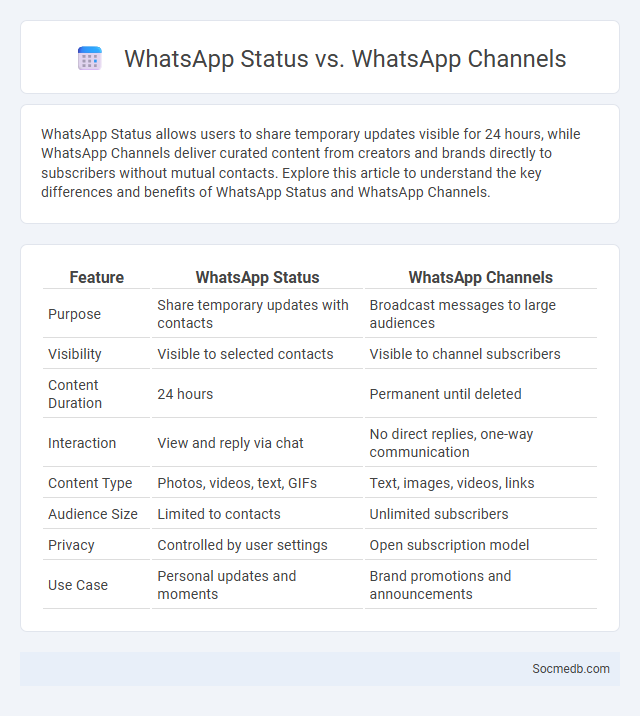
Photo illustration: WhatsApp Status vs WhatsApp Channels
WhatsApp Status allows users to share temporary updates visible for 24 hours, while WhatsApp Channels deliver curated content from creators and brands directly to subscribers without mutual contacts. Explore this article to understand the key differences and benefits of WhatsApp Status and WhatsApp Channels.
Table of Comparison
| Feature | WhatsApp Status | WhatsApp Channels |
|---|---|---|
| Purpose | Share temporary updates with contacts | Broadcast messages to large audiences |
| Visibility | Visible to selected contacts | Visible to channel subscribers |
| Content Duration | 24 hours | Permanent until deleted |
| Interaction | View and reply via chat | No direct replies, one-way communication |
| Content Type | Photos, videos, text, GIFs | Text, images, videos, links |
| Audience Size | Limited to contacts | Unlimited subscribers |
| Privacy | Controlled by user settings | Open subscription model |
| Use Case | Personal updates and moments | Brand promotions and announcements |
Introduction to WhatsApp Status, Channels, and Status Updates
WhatsApp Status allows users to share text, photos, videos, and GIFs with their contacts for 24 hours, enhancing real-time social interaction. Channels provide curated content streams from creators or organizations, enabling followers to receive targeted updates and exclusive information. Status Updates serve as a dynamic communication tool, combining multimedia elements to foster engagement and personalized expression within the WhatsApp ecosystem.
What is WhatsApp Status?
WhatsApp Status is a feature within the WhatsApp messaging app that allows you to share photos, videos, and text updates with your contacts for 24 hours. This status update is visible only to selected contacts based on your privacy settings, ensuring control over who views your content. By utilizing WhatsApp Status, you can keep your friends and family informed about your daily activities and moments in a dynamic, visual way.
Understanding WhatsApp Channels
WhatsApp Channels provide a new way for businesses and content creators to broadcast updates directly to your audience without the need for group chats. This feature enhances communication by allowing one-way messaging, ensuring your messages are delivered clearly and efficiently to subscribers. Using WhatsApp Channels helps you maintain privacy while expanding your reach to a wider, targeted audience.
Defining WhatsApp Status Update
WhatsApp Status Update allows users to share text, photos, videos, and GIFs that disappear after 24 hours, providing a dynamic way to broadcast moments to chosen contacts. This feature enhances real-time communication by offering ephemeral content that mirrors Instagram Stories and Snapchat Snaps. By leveraging end-to-end encryption, WhatsApp ensures privacy and security for status sharing within personal and group networks.
Core Differences: Status vs Channels vs Status Update
Social media platforms differentiate between Status, Channels, and Status Updates by their core functions: Status refers to a user's current state or mood visible to others, Channels represent themed spaces or communities built around specific interests, and Status Updates are the real-time posts or messages shared within these Channels or on personal profiles. Your engagement varies depending on whether you're sharing a brief Status or broadcasting a detailed Status Update in a Channel designed for targeted interaction. Understanding these distinctions enhances your ability to leverage social media for precise communication and audience reach.
Features Comparison Table
A social media features comparison table highlights key functionalities such as user engagement tools, content formats, privacy settings, and advertising options across platforms like Facebook, Instagram, Twitter, and TikTok. This comparison aids marketers in selecting the ideal platform based on metrics like audience reach, algorithm type, and analytics capabilities. Understanding these features enables businesses to optimize social media strategies for maximum impact and ROI.
Privacy and Audience Control
Social media platforms offer various privacy settings that empower you to control who can see your content and personal information. Customizing audience controls ensures your posts are shared only with trusted friends, family, or specific groups, reducing the risk of unwanted exposure. Regularly reviewing these settings enhances your online security and protects your digital footprint from advertisers, hackers, and unauthorized users.
Content Types and Sharing Capabilities
Social media platforms offer diverse content types including images, videos, stories, live streams, and articles, enhancing engagement and reach. Your ability to share multimedia content across networks like Instagram, Facebook, TikTok, and Twitter maximizes visibility and interaction with your target audience. Advanced sharing capabilities such as tagging, hashtags, and direct messaging facilitate precise content distribution and audience targeting.
Use Cases: Personal vs Business Communication
Social media serves distinct use cases for personal and business communication, with personal interactions centered on sharing life updates, maintaining relationships, and entertainment through platforms like Facebook, Instagram, and TikTok. For businesses, social media is essential for brand promotion, customer engagement, targeted advertising, and managing public relations across LinkedIn, Twitter, and industry-specific networks. Your choice of platform and content strategy should align with your communication goals to maximize impact and audience relevance.
Choosing the Right Feature for Your Needs
Selecting the right social media features depends on your content goals, audience engagement, and platform strengths. For visual storytelling, prioritize features like Instagram Stories, Reels, or Pinterest pins, which enhance image and video sharing. If community interaction and real-time updates are key, consider Twitter spaces, Facebook Groups, or LinkedIn events to foster engagement and networking.
 socmedb.com
socmedb.com